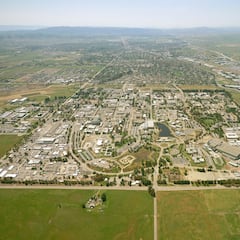When can the new nuclear fusion energy be industrialized and when will we be able to use it?
A major breakthrough in nuclear fusion energy was achieved, the first net energy gain. When will the “Holy Grail” of clean energy be available to the grid?

Researchers at the Lawrence Livermore National Laboratory (LLNL) experimental nuclear fusion reactor in California made a “major scientific breakthrough” at producing the “Holy Grail” of clean energy. For the first time anywhere on Earth a net energy gain from a fusion reaction was demonstrated.
However, the fusion reaction at the National Ignition Facility (NIF) was very brief, “about only a few billionth of seconds.” And people shouldn’t get their hopes up that it will solve our energy needs just yet.
“I don’t want to give you a sense that we’re going to plug the NIF into the grid; that’s not how this works,” Dr Kim Budil, LLNL Director told reporters when presenting the results of the accomplishment. “But this is the fundamental building block of an inertial confinement fusion power scheme.”
Nuclear fusion on a commercial scale is still decades away
The achievement at the NIF “demonstrates the basic scientific feasibility of inertial fusion energy,” according to Tammy Ma, Lead of the Inertial Fusion Energy Institutional Initiative. As well it “sets the roadmap for us to move forward to have even higher gains and towards fusion power pilot plants in the coming decades.”
Researchers will now try to create ever bigger nuclear fusion reactions and learn to sustain them so that the energy can be harnessed to one day connect it to the electricity grid. The scale of energy produced at the NIF would need to be ramped up by a considerable degree for it to become a source of energy to power homes and industry.
Jeremy Chittenden, co-director of the Centre for Inertial Fusion Studies at Imperial College in London explained to CNN just how much energy was produced in the experiment. “It’s about what it takes to boil 10 kettles of water. In order to turn that into a power station, we need to make a larger gain in energy – we need it to be substantially more,” he said.
For the first time ever, scientists at the Lawrence Livermore National Laboratory in California have achieved a nuclear fusion reaction that resulted in a net energy gain, sources said https://t.co/GvFnOcLu9x pic.twitter.com/CYxWw9x1FQ
— Reuters (@Reuters) December 13, 2022
International experimental nuclear fusion reactor ITER behind schedule
Researchers have been investigating nuclear fusion since at least the 1930s. The US government began funding project to harness the clean and virtually limitless form of energy in the 1950s. Since then it has spent billions with a current annual outlay of around $700 million.
That money pays for research not just around the US but also for the ITER experimental reactor under construction in France. The international endeavor involving 35 countries was conceived in 1985 but wasn’t launched until 2007. Ground broke on construction of the experimental fusion reactor in 2013 with the aim of producing its first full fusion reaction by 2023.
However, creating nuclear fusion energy is incredibly difficult and the project has run into many delays. The latest target is to do the first plasma test in December 2025, and then a full fusion reaction in 2035. However, there are no plans for it to supply energy to the grid.
Can you imagine to align your books with a positional accuracy smaller than the width of a human hair? That would be the same level of precision that is required to position #ITER's 17-metre-tall, 360-tonne D-shaped magnets.
— ITER (@iterorg) December 14, 2022
Read more here: https://t.co/JVAejebCpI#metrology pic.twitter.com/lRrV0ZnS0T
The UK wants to have a commercial nuclear fusion reactor running by 2040
The UK government has pledged over £220m ($267m) for the STEP (Spherical Tokamak for Energy Production) program. The facility would be up and running by 2040 and replace a coal-fired power station that is supposed to close this year.
It would be the first commercial nuclear fusion power plant “capable of putting energy on the grid,” according to the government. However, “there are still huge hurdles to overcome before the technology is viable” according to researchers.
The SPARC project fusion reactor set to start tests in 2025, hook to grid in 2030s
Commonwealth Fusion Systems, a spinoff from the Massachusetts Institute of Technology, has begun construction on an experimental nuclear fusion reactor outside of Boston, Massachusetts. Researchers plan to start operating the facility in 2025 and a year or two thereafter cross the net energy threshold where it produces as much energy as is put in, or “breakeven.”
Commonwealth Fusion Systems has raised more than $1.8 billion from the likes of Bill Gates and George Soros as startups race to generate carbon-free energy like the sun https://t.co/VoRRuUiIS2
— The Wall Street Journal (@WSJ) December 2, 2021
A second facility, ARC, is planned that would actually generate 400 megawatts of power and would be connected to the grid in the early 2030s. Power plants typically generate between 100 to 500 megawatts in the US, but a typical nuclear power plant produces a gigawatt, about 2.5 times what ARC would generate.
Related stories
Researchers think that they could get up to 1,000 megawatts from a single facility using the SPARC fusion technology.
Like the ITER and the planned facility in the UK, SPARC uses a tokamak, in technical terms a torus, which is a doughnut-shaped chamber that uses powerful magnetic fields to condense the heavy hydrogen gas into an incredibly hot plasma triggering fusion inside. Inertial fusion on the other hand uses multiple lasers, 192 in the case of the LLNL, to compress a capsule of heavy hydrogen to create fusion ignition.


